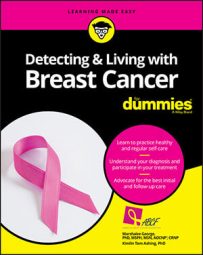If your first-degree relative (mother, father, sister, or brother) had breast cancer or ovarian cancer (females), your risk of having breast cancer is at least five times more than the general population without a family history of breast cancer. Your risk for breast cancer can be even higher than than that if your first-degree relative was diagnosed under age 50.
Tracing your family tree (genogram) is always helpful in providing a visual picture of family members who have had a history of cancer. It can also help providers to identify where the cancer clusters are in the family and which cancers you may be at risk for.
BRCA1 and BRCA2 (BReast CAncer susceptibility) genes are found in both men and women. When functioning normally, these genes produce special types of tumor suppressor proteins to repair damaged DNA in our cells. However, sometimes these BRCA genes are altered or mutated, and the proteins don't function normally. Sometimes damaged DNA is not repaired correctly, and then the cells are more likely to further develop with genetic changes that can lead to the development of cancer.The BRCA mutation is detected by a genetic test, blood test, or from saliva, one of which is usually recommended if you have a family history of breast and ovarian cancer. The BRCA-mutated gene can be passed from your mother or father to you or siblings. If one of your parents has the gene, you have a 50 percent chance of inheriting the mutation. The two main types of BRCA genes, called BRCA1 and BRCA2, are both associated with an increased risk of female breast and ovarian cancers, and their presence accounts for 10 percent of all breast cancers and 15 percent of all ovarian cancers. When you have the BRCA1 or BRCA2 mutation, you are at risk for developing breast and ovarian cancer at a much younger age than other women who do not have the mutation.
It is important to note that not every person with breast cancer needs genetic testing. Individuals are tested for BRCA1 and BRCA2 mutation based on their genetic risk that assesses personal and family history factors, such as the following:
- Breast cancer diagnosed before age 50
- Cancer in both breasts in the same woman
- Multiple breast cancers in the same woman
- Both breast and ovarian cancers in either the same woman or the same family
- Two or more primary types of BRCA1- or BRCA2-related cancers in a single family member
- Male breast cancer
- Ashkenazi Jewish ethnicity
If your family history is suggestive of a possible BRCA1 or BRCA2 mutation, the best thing to do is first test the family member with the known breast cancer. If that person is found to have a BRCA mutation, then other family members should consider genetic counseling to understand their potential risk for breast and ovarian cancer.
If you were adopted or otherwise don't know your family history and are diagnosed with breast cancer or ovarian cancer under age 50, it will be beneficial for you to consider genetic testing for BRCA1 and BRCA2. This will help you determine your risk for having a recurrent breast cancer or ovarian cancer, as well as your risk of passing it to the next generation (if you have or plan to have children).If you have either the BRCA1 or BRCA2 mutation, there are recommended measures you can take to reduce your risk of breast and ovarian cancer according to the National Comprehensive Cancer Network (NCCN) guidelines, as follows:
- Screening for breast cancer:
- Observe your breast for changes, starting at age 18
- Have a clinical breast exam performed by your doctor or nurse every 6 to 12 months starting at age 25
- Have a screening breast MRI annually, starting at age 25 or 30
- Consider a 3D tomosynthesis mammogram
- Screen after age 75 according to individual choice
- Reducing breast cancer risk:
- Consider removing the breasts (mastectomy)
- Consider risk-reduction medications (endocrine therapy: tamoxifen, anastrozole, letrozole, and so on)
- Reducing ovarian cancer risk:
- Remove the ovaries and fallopian tubes at the end of childbearing age
- Postpone removal of ovaries and fallopian tubes until mid-forties, especially in individuals who have completed risk-reduction mastectomies on both breasts
- Annually screen for ovarian cancer with the use of blood test CA-125, and transvaginal ultrasound if recommended by your doctor, starting at age 30
Note that there may be other genetic mutations that are inherited (passed on) to family members that lead to breast cancer. This is rare, but there are families with multiple members who have breast cancer that do not have the BRCA1 or BRCA2 mutation. It may be that scientists have not yet discovered the gene involved. At this time, the BRCA1 and BRCA2 genes are the ones that have been studied the most and are the most common cause of inherited breast cancer.

